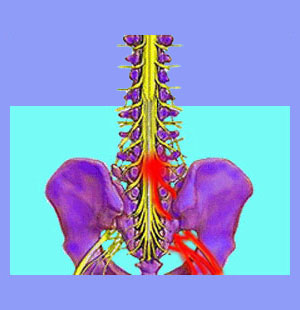
Doctors and chiropractors generally concentrate on managing sciatica, rather than curing it. Since sciatica has proven itself to be such a persistent and long-term health problem for most patients, the actual focus of treatment has shifted over the years towards symptom management, rather than attempts at enacting a cure. The reasons for this change are many and varied, with some unfortunate sinister overtones involving financial motivation virtually always being present.
The result of this paradigm shift in treatment methodology has caused profound negative effects on patients. Most do not even expect to find a cure at this point, since their caregivers have them so thoroughly conditioned to anticipate long lasting symptom-based care. This is a dangerous trend throughout the larger healthcare system, as well. It is a trend that is particularly disturbing to us, since it shines a bright light on the business side of medicine rather than its pure purpose of improving and preserving health.
This critical editorial provides a detailed account of why symptomatic treatment has become the norm in the sciatica care sector. We will examine the tangible concerns with symptom-based care practices, as well as the equally important psychological effects of feeling “impossible to cure”.
Managing Sciatica Versus Curing It
A cure denotes an ideal scenario wherein the underlying root cause of pain and related symptomology is accurately identified, evaluated and treated successfully and permanently. Cures provide a complete return to normal form and function and do not impede living normally due to continuing chronic pain or the need for ongoing treatment. Cures are the primary purpose of medical science.
Symptom-based, also known as symptomatic treatment or symptom management, is considered second-rate medicine, since it does not seek to identify, evaluate or treatment the underlying cause of pain and related symptoms. Instead, it merely uses methods of care that reduce pain, but do nothing to actually stop it from recurring or continuing. Symptomatic care is taught to be a substandard practice in every medical school in the world and should be reserved for conditions where no cure is available. Ironically, despite these facts, symptomatic care has become the gold standard for virtually all musculoskeletal issues, including common back and neck pain problems.
Now that we are clear on the contrasting definitions of symptomatic and curative care, we can proceed to examine why managing sciatica pain has become more prevalent than curing it.
Why Has Managing Pain Become the Norm?
There are several main contributing factors to the development of symptomatic treatment as the standard of care. However, these factors have one common link driving all of them: money. Economics has shaped modern medicine more than any other factor, including knowledge, technology and ethics. Financial motivations have determined everything we experience in healthcare, from covered practices to treatments received and from duration of care to the doctor’s actual bedside manner. Let’s talk about how money has reconfigured everything involved in sciatica therapy, starting at the beginning of the treatment process:
In order to treat a condition, one must first positively identify the root cause of the problem and discount any incidental factors that are noncausative. This is called diagnosis. Diagnosis is a messy and time-consuming process for doctors to handle. There are so many variables to account for and many past bias misconceptions to overcome in blaming coincidental structural abnormalities for pain. All in all, it is far easier to abide by the mistakes of old and simply use fast imaging studies to find anything that looks “out of the ordinary” and then blame that issue for the pain. This is done regardless of logic or link to the correlation of symptoms.
The most profitable methods of care are certainly all symptomatic in nature. Ongoing therapy of any type creates repeat customers, rather than one-time clients. It is most economically rewarding to perpetuate the doctor/patient relationship indefinitely through continuing care.
Pharmaceutical therapy is the ultimate in “cure-nothing, manage-everything” treatment. Since big pharmaceutical companies are also some of the richest and most profitable in the world, they have no problem literally paying caregivers to prescribe their products. Doctors can merely write scripts and earn millions each year without having to get involved in messy and time-consuming diagnostic endeavors or curative practices. Patients keep coming back for more drugs, the incentive checks keep coming in and all is well in life for these greedy medical “professionals”, regardless of the damage being done to the health of their patients.
The growth of complementary healthcare practices has also dramatically encouraged the management of symptoms, rather than the implementation of curative interventions. While massage, acupuncture and other natural sciatica treatments are certainly preferred to drug therapies, these modalities usually do not provide even a remote possibility of curing pain permanently. Doctors can simply associate with a variety of hands-on therapists and can therefore make money without having to treat any patient at all. This frees them up for time spent on the golf course or on vacation…
In summary, time is money and patient care simply becomes more profitable when symptom-based practices are utilized long-term.
Consequences of Managing Sciatica
While doctors get rich from symptomatic care tactics, patients do not fare so well. The one upside of ongoing conservative care is that patients can usually successfully avoid the potential horrors of spinal surgery, which is a very good thing, since most operations are not needed to begin with. However, this is where the positive benefits of symptom-based care abruptly end. Instead, most patients suffer any or all of the consequences detailed below:
Patients must endure continuing financial hardship from the cost of ongoing care. Many complementary therapies are not covered by insurance and virtually all healthcare services require regular co-pays. For patients without any insurance, long-term symptomatic care can literally drain their finances, creating further stress and subsequent related health problems.
Patients become conditioned to expect recurrent pain and also to rely on treatment to find temporary relief. Many times, the efficacy of continuing care is based completely on placebo and programming, forcing the patient to become a literal slave to the therapy or provider.
Patients with long-term pain suffer a decreased life span, increased risk for developing additional serious health problems, and also suffer a variety of potentially serious psychoemotional disorders, such insomnia, listlessness, malaise and depression. More importantly, some patients simply lose hope in ever finding relief and acquiesce to a life spent in pain and governed by their symptoms. The far-ranging effects of this mindset are catastrophic and have guided and inspired my own career path as an expert chronic pain coach.
Finally, since patients are focused on treating the physical body, most never take the time to consider knowledge-based alternative medical practices that might provide a cure. It is a well known fact that many chronic pain issues are psychogenic in nature and no amount of physical treatment will ever relieve them. Furthermore, even for structurally-based conditions, there is always a psychological overlay phenomenon that can be mitigated to reduce pain and suffering, and eliminate the need for most ongoing medical care.






